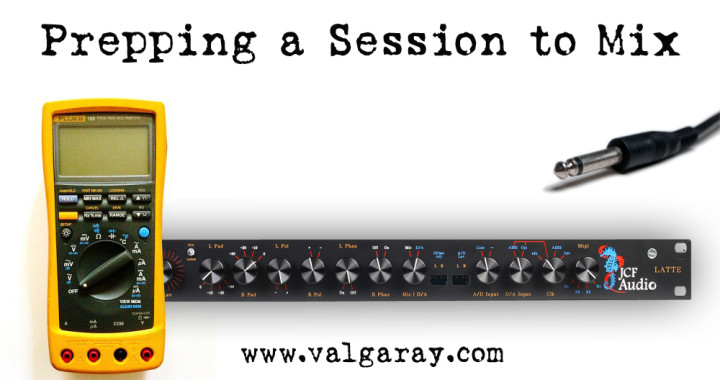Prepping a Session to mix - Part III: Editing

In part I of “Prepping a Session to Mix,” we covered the importance of creating a session template as a starting point where individual tracks are organized, grouped, and prepared to be mixed, and all of one’s tools (reverbs, delays, EQ’s, compressors, etc.) are in place and ready to be utilized. In part II, we covered analog summing and stereo buss signal flow, how to calibrate, document, and take advantage of analog processing, and how to configure a second computer where the final mixes go through top-of-the-line converters and are recorded at 192kHz and 32-bit float. At this point, all of the software and hardware are ready to go, but there’s still one crucial component to preparing a session to mix that we have yet to cover…and that element is editing.
When I receive a song to mix, I plan on dedicating a decent portion of time to cleaning up the session. The first thing I look to remove from the mixing session is unwanted noise in between the valuable pieces of audio. This could be headphone bleed, room ambience, a player rustling about between sections, etc. One way to remove this undesirable audio is with the strip silence tool in Pro Tools, which is a real timesaver. Another option is to do it by hand, which I prefer to do often to ensure precise edits. I make sure to utilize fade-ins and fade-outs when necessary, and then reconsolidate the tracks.
If a song has real drums, the toms need to be checked for bleed, but like I always say, you can’t be afraid of leakage. Sometimes the leakage between fills actually makes the drums as a whole sound bigger, in which case it wouldn’t need to be removed. However, if the toms are ringing throughout the song or the leakage is generally unpleasant to the overall drum sound, they need to be gated or hand edited to occur only when they’re played. Gating the toms is often sufficient (I tend to use the MH Channel Strip plugin) but at times it’s unnatural sounding and I choose to edit them by hand, which has a smoother sound in general. By the end of this process, the toms should fully ring out and then fade out by the next downbeat or snare hit.
Once the toms are situated, I listen for three issues throughout a song, both globally and on the individual tracks to make sure that nothing is sticking out in terms of timing, inconsistent levels, and tuning.
Timing issues usually occur from an individual instrument straying too far out of time with the drums, or a band playing a part too loose in general, like a section with complicated breaks or a ritardando (*Ritardando - *slowing down gradually) at the end of a track. I usually tighten up these types of edits by hand, but if an instrument is out of time for the whole song or a larger section, I may end up quantizing it to see if it helps (as long as the song is recorded to a click, although it might sometimes work, even if it wasn’t).
Often times, inconsistent level issues happen when an instrument or voice has varying dynamics that move wildly throughout the track, and often occur from poor engineering during the recording process. These issues can be easily fixed by gaining up or down the audio, so there aren’t as many dips and peaks throughout the track. Clip gain is a great feature in Pro Tools for this type of editing. Leveling the severe dynamics keeps the instruments, and especially vocals, sounding more audible and even in the track. If a compressor is engaged, it doesn’t have to work as hard in order to even out the audio.
Tuning issues are usually limited to vocals, but on rare occurrences, can pop up on other instruments as well. I do mostly all of my tuning in Melodyne, as I’ve found it to be the most transparent and versatile of all the tuning software. Once the audio is imported into Melodyne and tuned up, I “commit” the file as a method of printing the tuned audio to a new track. I then drag it to the same track over the original audio, make Melodyne inactive and I’m done.
If I’ve determined that vocals need tuning on a track, I’ll begin with the lead vocal, then move on to the backgrounds and harmonies, so that the secondary vocal parts can be tuned according to the nuances of the lead.
Vocals require a few aspects of editing that don’t apply to other instruments; those are plosives and breaths. Plosives, or pops, are easily corrected with a high-pass filter. If that doesn’t do the trick, you can always hand edit them. I process them with the Fab Filter Pro Q-3 with the high-pass filter set at 115 Hz and a 12dB per octave ratio. If hand editing, I’ll made an edit before the pop and fade into it, moving the length of fade farther in until the plosive isn’t noticeable anymore.
Breaths are usually desirable on the lead vocal track, but I always remove them from a double vocal and often remove them from the harmony and background vocal tracks so that they don’t get in the way, and this keeps the track clean as well.
If harmony, backgrounds, or double vocal tracks seem too loose, I’ll duplicate the playlists in order to preserve the originals. Then I use Synchro Arts - Vocal Align Pro 6 or Revoice Pro to tighten them up with the lead vocal or to the voice singing the melody part if there’s no lead vocal in a particular section.
The final step before beginning the mix is to set the fade-outs on all of the tracks at the end of the song, and determine the exact spot that the song ends, remembering always to keep the fades sounding natural.


